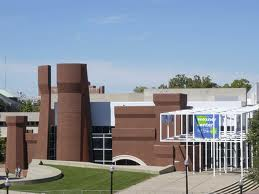Time to check in on the Wexner Center for the Arts. Why? The Wex (below) just won a four-year $782,300 grant from the Andrew W. Mellon Foundation to develop multidisciplinary “trans-institutional” curatorial research and programming with visual artists and media artists in Brazil. That’s pretty substantial amount of money, and the grant reflects not only the vibrancy of the Brazilian arts scene but also the desire of many American arts groups to catch up on what’s going on in Latin America.

And that’s a good thing.
It’s unclear whether this is a new direction for the Mellon, however. The foundation has changed a bit since music historian Don Michael Randel took over as president in mid-2006, but its website gives no indication of a broad new investment in grants like the Wexner’s.
Nor do its other recent grants: Among them are a $1.25 million award to the Duke University Libraries to endow a senior conservator; $2.4 million to Emory University and $10 million to the University of Wisconsin-Madison, both to support the humanities; and $172,000 to rebuild the infrastructure of the Cuban Theater Digital Archive at the University of Miami Libraries.
The Mellon website holds no clues (its museum and art conservation section remains the same), and when I asked the Wexner about it, spokeswoman Karen Simonian queried Mellon. Her “Mellon contact,” Simonian said, replied: “The Foundation works on an iterative basis with lots of grantees, usually soliciting proposals from specific institutions in any of the areas we serve across higher ed and the arts and humanities after we have gone through field-based inquiries into current needs and interests. So we have no broad calls for proposals…” in this area.
The Wexner says it was one of several museums and arts centers invited to apply for a Mellon grant last fall; Ohio State, the Wexner’s home, is internationalizing and globalizing its offerings and outlook, so this initiative fit right in.
In its press release, the Wexner elaborated a bit on how it will use the money:
The Wexner Center’s Brazil project will be shaped in large measure by establishing intensive and ongoing relationships with key Brazilian artists, cultural thinkers and practitioners, academics, critics, and institutional peers in the areas of visual arts, film/video, and arts education.
Together, these efforts will result in several manifestations, among them: an ambitious visual and media arts exhibition at the Wex in the 2014 season, related print and electronic documentation, an archival or repertory film project and series, and artist residencies for film and video artists. The center will organize scholarly convenings, as well as more accessible public lectures and seminars, to encourage transnational dialogue.
Throughout the evolution of the Brazil project, the center will seek to establish new avenues for cultural exchange, critique, and commentary, and will–as appropriate–pursue broadcast-quality dissemination of programs via streaming video, social media outlets, and other online means. At the same time, while not under the auspices of the proposed Mellon Foundation grant, the center’s performing arts department will likewise pursue projects involving Brazilian artists, companies, and institutions producing music, theater, and dance to further enrich the center’s comprehensive engagement with Brazil.
As I’ve talked with museum directors over the last year or so, many have mentioned the need to do more with contemporary art from Latin America. The Cisneros Foundation is helping, both by lending art to museums like the Museum of Fine Arts, Boston, for its new Art of the Americas wing (here) and publishing books on Latin American artists.
The Museum of Fine Arts, Houston, under the late Peter Marzio, also distinguished itself with the creation, ten years ago, of the International Center for the Arts of the Americas, a research institute focused on Latin American art.
I don’t believe in cookie-cutter museums — so not every museum needs to focus on Latin America. But some should, and make it one of their distinugishing characteristics.
Photo Credit: Courtesy of Ohio State University
